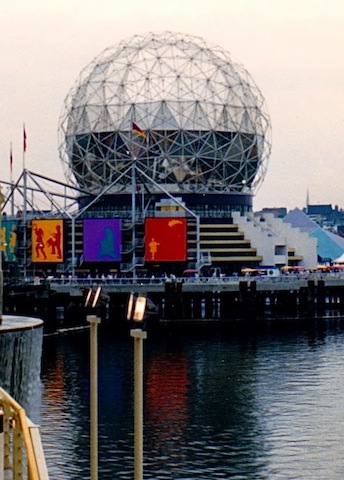Tuesday, April 29, 1986.
AN IMAX PROJECTION BOOTH feels like the bridge of an aircraft carrier. The projector is nearly as big as a Volkswagen, and the area of its screen is equal to that of a full-sized tennis court with enough space left over to park five cars.
The operative word here is big. Canada's contribution to large-format cinema, IMAX is the motion-picture system that maximizes the size of the image.
Based on the principle that a bigger picture is a sharper picture, IMAX cameras use 70mm film stock and run it past the shutter horizontally. This produces a postcard-sized image, a movie frame that is three times larger than regular vertical-pull (standard theatrical) 70mm.
This, in turn, produces a huge, clear picture on the IMAX theatre screen. The illusion of reality is so intense that the Canada Pavilion has taken the precaution of supplying its 530-seat CN IMAX Theatre with motion-sickness bags.
A recent innovation, IMAX was developed by Graeme Ferguson, Robert Kerr and Roman Kroitor, a team that came together at Canada's National Film Board. As a group, they worked on Labyrinth, the NFB's multi-screen Expo 67 production. Shortly after, they recognized the potential in a new projection mechanism invented by an Australian named Ron Jones.
First demonstrated at Osaka's Expo 70, IMAX found a permanent home in Toronto's Cinesphere, the 27-metre-high triodetic dome that dominates that city's Ontario Place entertainment centre. A spectacular addition to urban science museums and entertainment complexes, more than 35 custom-built IMAX theatres are now [1986] in operation around the world.
Many feature the even more imposing OMNIMAX, a projection system that uses a fish-eye lens to fit the IMAX picture to a dome-shaped screen. Vancouver's Expo Centre, opened last May 2, [1985] is an OMNIMAX venue, and it will present director Michel Brault's 20-minute A Freedom to Move for the run of the fair.
Making its world premiere at the new CN IMAX Theatre is Colin Low's Transitions, the first live-action IMAX film shot in 3-D. Commissioned by the Canadian National Railway, Low's picture uses Expo's transportation theme to demonstrate the breathtaking potential of this new stereoscopic screen process.
IMAX will remain a permanent feature of Canada Place following Expo 86. The future of the Expo Centre's OMNIMAX installation is, as yet, undecided.
The above is a restored version of a Province Expo 86 preview feature by Michael Walsh originally published in 1986. For additional information on this archived material, please visit my FAQ.
Afterword: Designed by Expo 86's chief architect, Trail, B.C.-born Bruno Freschi, the Expo Centre was opened in 1985 to offer Vancouverites a preview of the fair to come. Although the 17-story triodetic dome, known to locals as "the golf ball," was slated for demolition when the show closed, a citizen's group lobbied for its preservation as an educational science centre. Extensively renovated, it reopened on May 6, 1988 as Science World. The facility retained its 400-seat theatre that boasted the largest OMNIMAX domed screen in the world, a distinction it retains to this day. Earlier in this series, I wrote about the IMAX 3D process, and will have more to say following my review of the Canada Pavilion film, director Colin Low's Transitions.
See also: The 13 articles included in this, the first of four Expo 86 special reports, are:
